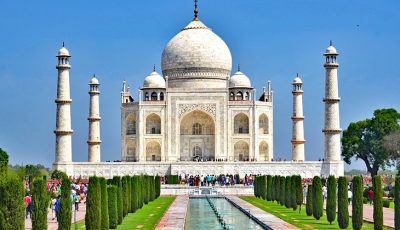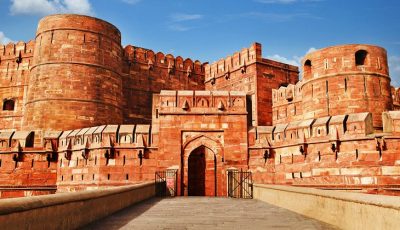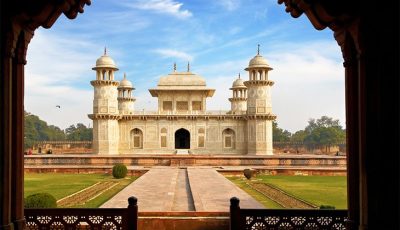The Taj Mahal ivory-white marble mausoleum on the right bank of the river Yamuna in the Indian city of Agra. It was commissioned in 1632 by the Mughal emperor Shah Jahan (r. 1628–1658) to house the tomb of his favorite wife, Mumtaz Mahal; it also houses the tomb of Shah Jahan himself. The tomb is the centerpiece of a 17-hectare (42-acre) complex, which includes a mosque and a guest house, and is set in formal gardens bounded on three sides by a crenelated wall.
Construction of the mausoleum was essentially completed in 1643, but work continued on other phases of the project for another 10 years. The Taj Mahal complex is believed to have been completed in its entirety in 1653 at a cost estimated at the time to be around ₹32 million, which in 2020 would be approximately ₹70 billion (about US $1 billion). The construction project employed some 20,000 artisans under the guidance of a board of architects led by the court architect to the emperor, Ustad Ahmad Lahauri. Various types of symbolism have been employed in the Taj to reflect natural beauty and divinity.
The Taj Mahal was designated as a UNESCO World Heritage Site in 1983 for being “the jewel of Muslim art in India and one of the universally admired masterpieces of the world’s heritage”. It is regarded by many as the best example of Mughal architecture and a symbol of India’s rich history. The Taj Mahal attracts more than 6 million visitors a year and in 2007, it was declared a winner of the New 7 Wonders of the World (2000–2007) initiative.

The Taj Mahal is an icon of India and one of the top tourist attractions in the world, drawing millions of visitors to the city of Agra every year. This breathtaking landmark is every bit as incredible as you’ve imagined. But while most travelers might be eager to escape Agra’s pushy touts and exhausting crowds as soon as they’ve left the Taj Mahal, you should consider sticking around a bit longer.
The Taj Mahal is just one of many amazing places to visit in Agra. While here, you can explore the historically significant Agra Fort; experience the impressively beautiful Tomb of Itimad-ud-Daulah; see one of the largest mosques in India at Fatehpur Sikri; and find respite in Mehtab Bagh, a serene park in the shadows of the Taj.
 Agra fort is a historical fort in the city of Agra in India. It was built during 1565-1573 for Mughal Emperor Akbar. It was the main residence of the rulers of the Sikarwar clan of Rajputs until the Mughals occupied it and Mughal Dynasty until 1638 when the capital was shifted from Agra to Delhi. It was also known as the “Lal-Qila”, “Fort Rouge” or “Qila-i-Akbari”.
Agra fort is a historical fort in the city of Agra in India. It was built during 1565-1573 for Mughal Emperor Akbar. It was the main residence of the rulers of the Sikarwar clan of Rajputs until the Mughals occupied it and Mughal Dynasty until 1638 when the capital was shifted from Agra to Delhi. It was also known as the “Lal-Qila”, “Fort Rouge” or “Qila-i-Akbari”.
Before its capture by the British, the last Indian rulers to have occupied it were the Marathas. In 1983, the Agra fort was life inscribed as a UNESCO World Heritage Site. It is about 2.5 km northwest of its more famous sister monument, the Taj Mahal. The fort can be more accurately described as a walled city.
 The city of Agra is full of architectural wonders. On one hand, it has the famous Taj Mahal, and on the other hand, it has the Agra Fort and Itmad-ud-Daulah’s mausoleum.
The city of Agra is full of architectural wonders. On one hand, it has the famous Taj Mahal, and on the other hand, it has the Agra Fort and Itmad-ud-Daulah’s mausoleum.
Itmad-ud-Daulah’s tomb is a highly ornate edifice, which is looked upon as an imminent precursor of the Taj Mahal as far as elaborate carvings and inlay work are concerned. The tomb marks a significant departure from the tombs of the Mughal dynasty built before its construction.



